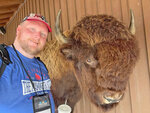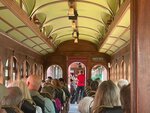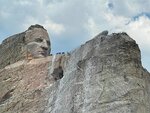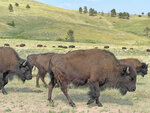











I love exploring new places, meeting new people, and learning new things. That’s partly why my job as a journalist is a perfect fit. But it’s also why I love traveling to places across our beautiful country and beyond.
For my 36th birthday in July, I celebrated with a trip to South Dakota. My wife and I joined a tour group through Premier World Discovery that included 30-plus other people from all over the country.
To some, South Dakota may not seem like the ideal vacation spot. However, it was perfect for me because it combined my love of nature and history.
Rapid City, SD was our group’s home for the weeklong excursion after landing at the Rapid City Regional Airport. In a state where prairie, grassland and farmland cover 90 percent of the state, the small airport seemed like it was in the middle of nowhere. But plenty of big adventures awaited.AMERICAN PRIDE
Since South Dakota is known as “The Mount Rushmore State”, no visit to our country’s 40th state would be complete without a visit there. It was our first excursion.
Rows of colorful flags representing every state welcomed us and guided our group to the 60-foot-tall monument. It was incredible to see the craftsmanship that went into carving such a monument that’s surrounded by natural beauty. It was also neat to watch a hoop dance by a Native American dancer, a nice tribute to the area’s Native American roots.We later returned for the evening program where the monument was lit up as a park ranger and film enlightened us on the four presidents forever memorialized in stone.
“They illustrated the American experience, but more than that they illustrate what it is to be American. As each of these men contributed to our nation, they contributed to our meaning of what it is to be a part of this nation. They did so through their words and actions. Those words and actions still guide us resonate with us today,” stated the park ranger.
Mt. Rushmore honors George Washington, Thomas Jefferson, Abraham Lincoln, and Theodore Roosevelt. They represent the birth, growth, preservation and development of our great nation.
They embody the spirit of our nation and served as advocates of freedom, dignity and the ideals of American life.
Mt. Rushmore reminds us of the heroes, history, leaders, accomplishments, sacrifices and ideals that have made this nation the land of the free. Freedom is America’s lasting legacy.
Mt. Rushmore gets a lot of the notoriety, but South Dakota has much more to offer than the iconic monument featuring four of our country’s former presidents. The state is filled with scenic wonders, majestic wildlife, Native American culture, unique history, delicious food, old west charm, and some eclectic stops along the way.
NATIVE AMERICAN CULTURE
After Mt. Rushmore, we made a short journey to the Crazy Horse Memorial.
Like Mt. Rushmore, the Crazy Horse Memorial uses stone to honor a man who is of great importance to our country’s past and future. Unlike Mt. Rushmore, Crazy Horse Memorial receives no federal or state money because the founding family wanted no government influence. Instead, it is entirely self-sufficient through fees, merchandise, and donations. Also, Crazy Horse Memorial is not yet completed, despite being underway since 1948, partially due to the funding difference.The museum at the Crazy Horse Memorial is an impressive tribute to the 19th century Oglala Lakota war leader who took up arms against the U.S. government. He fought to preserve the traditional way of life of the Lakota that was being threatened by the encroachment of White American settlers.
Though it still has a long way until completion, the Crazy Horse Memorial will eventually depict Crazy Horse riding a horse and pointing to his tribal land. The memorial was commissioned by Henry Standing Bear, a Lakota elder, to be sculpted by Korczak Ziolkowski, whose family still oversees the project.
Seeing the commitment that the Ziolkowski family has to complete this massive undertaking is quite impressive. It’s a great example to never give up on your dreams.
SCENIC WONDERS & MAJESTIC WILDLIFE
The natural beauty of South Dakota is vast and ever changing. If you blink, you might miss something. That beauty always surrounded our journey, whether we were on the plane, train, bus or just walking around.One highlight was the rugged beauty of Badlands National Park, a 244,000-acre colorful home of fossil beds and grassland.
At one point many, many years ago, this place was a sea. It’s now dry land with very few trees. Scientists have found no signs of people ever inhabiting this land permanently, likely due to the heat, lack of water and other conditions. Ancient horses and rhinos once roamed this mixed-grass prairie where bison, bighorn sheep, prairie dogs, and black-footed ferrets live today. Rattlesnakes also call the Badlands home, though we thankfully didn’t encounter any.
The name “Badlands” comes from the Lakota Indians. Even the Spanish labeled this area “bad country” when they explored the area.Sweltering temps usually “welcome” visitors to the Badlands in the summer, but our group was fortunate that temps were 20 degrees cooler than normal. It was hot, but fairly pleasant. South Dakota lacks South Carolina’s humidity.
A highlight for me was a two-hour Jeep tour to look for buffalo (technically bison) at Custer State Park. We ran into about two-thirds of the herd of more than 1,300, including several nursing calves. We were within just a few feet of some of them. We also saw prairie dogs, antelope and other wildlife.Our Jeep driver reminded us multiple times to not stick our arms outside of the Jeep when we were close to the bison. While they appear to be gentle giants, they are fast and will react if they think they or their young are threatened. Awestruck tourists aiming to get the perfect photo shouldn’t get too close. According to a T-shirt I bought, “Don’t pet the fluffy cows.”
During a tour of the Mammoth Site Museum in Hot Springs, SD, we learned about a different type of “fluffy cow” – the now extinct mammoth.This museum and active paleontology excavation site was built on the site where mammoth bones were found in 1974 during construction of a housing project. The housing project never came to fruition and the landowner donated the land to a non-profit group that started to preserve the bones. Bones of 60 mammoths have been located along with other animals.
Why were so many mammoths found in one small spot? There was a sinkhole in this spot 140,000 years ago, during one of the warmer periods of the Ice Ages. It must have looked inviting with warm water and grass growing around the edges, but the sinkhole had slippery shale lining its steep sides, making it very difficult to climb out.
Though we mostly stayed in South Dakota, we briefly ventured into Wyoming to visit the Devil’s Tower national monument. This is our nation’s first national monument which was created by President Theodore Roosevelt in 1906 under the Antiquities Act as part of the millions of acres he preserved during his time as president.
It was refreshing to hike up the trail to get a closer look at the monument and the beautiful views in the valley below.
OLD WEST CHARM & HISTORY
South Dakota is full of unique history, from its prehistoric encounters and Native American heritage to pioneer tales and more.
A lot of this history was on display at the Journey Museum in Rapid City. This impressive museum took us on a journey through three billion years of stories and traditions that connected us with the people, cultures, and science behind the ancient Black Hills and prairies of Western South Dakota.
The Gold Rush and western expansion brought many historic figures to South Dakota, such as Lewis and Clark, Sitting Bull, and General George Custer.
We walked the streets of historic Deadwood, SD, where the colorful characters of Wild Bill Hickok, Calamity Jane, and others once roamed. This Wild West town formed in 1876 during the Gold Rush when prospectors came across a gulch full of dead trees – hence the name. Its charm and history live on.
One interesting fact about Deadwood is that prostitution was prevalent from 1876 to 1980, though it was illegal. However, they got away with it because it was a big money maker. Prostitutes donated money to schools for supplies. After the federal government shut down prostitution in 1980, the town replaced the lost revenue by applying for a gambling license that created many casinos.
We also got to ride a piece of history when we boarded the historic 1880 Train for an hourlong scenic journey through the Black Hills from Hill City to Keystone. These restored locomotives are steam powered by using recycled motor oil since coal and wood were outlawed in the area.UNIQUE ATTRACTIONS
No journey to South Dakota would be complete without a stop at the famous Wall Drug.
This started in 1931 as a small pharmacy. However, the town of Wall, SD only had 300 people at the time, so business was slow for the owners in this desolate area. That’s when the wife decided to offer “free iced water” to passersby who were journeying out west, including those checking out Mt. Rushmore. They also added supplies and other merchandise. Billboards were installed for hundreds of miles advertising “free ice water”, attracting many thirsty travelers.Wall Drug is no longer just a pharmacy. It’s a huge tourist destination, despite the town still being tiny. The 76,000-square-foot complex is filled with a restaurant that seats over 500, many stores, attractions like a gold mining area, fun decor like a moving dinosaur head and mini Mt. Rushmore, and much more. They still have a pharmacy. While it’s unlikely you’ll leave without spending some money, the iced water is still free.
We dined one evening at the State Game Lodge in Custer State Park. The lodge is over 100 years old and served as the “Summer White House” for President Calvin Coolidge and was visited by President Dwight D. Eisenhower.
Our amazing vacation ended with a dinner show at Fort Hayes Chuckwagon Supper & Show. It mimics an old west town and includes many buildings to represent an old west town. Some of the buildings are from the “Dances with Wolves” movie set which was filmed nearby.
If you haven’t experienced South Dakota, I encourage you to do so. But please remember, don’t pet the “fluffy cows.”